
The London Borough of Hackney is a London borough in Inner London, England. The historical and administrative heart of Hackney is Mare Street, which lies 5 miles (8 km) north-east of Charing Cross. The borough is named after Hackney, its principal district. Southern and eastern parts of the borough are popularly regarded as being part of east London, with the northwest belonging to north London. Its population is 281,120 inhabitants.
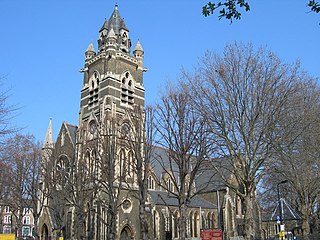
Dalston is an area of East London, in the London Borough of Hackney. It is four miles northeast of Charing Cross. Dalston began as a hamlet on either side of Dalston Lane, and as the area urbanised the term also came to apply to surrounding areas including Kingsland and Shacklewell, all three of which being part of the Ancient Parish of Hackney.

Dalston Kingsland railway station is a railway station on the North London Line in London, England. It is in the Dalston area of the London Borough of Hackney, on the western side of Kingsland High Street and opposite Ridley Road Market. The station and all trains serving it are operated by London Overground. It is in Travelcard Zone 2. Kingsland railway station was first opened on the site in 1850, but was replaced by Dalston Junction in 1865. The current station was opened by British Rail in 1983. Ticket barriers are in operation. The station straddles the boundary with the London Borough of Islington, with part of the platforms falling within Islington.

The Phoenix Cinema is an independent single-screen community cinema in East Finchley, London, England. It was built in 1910 and opened in 1912 as the East Finchley Picturedrome. It is one of the oldest continuously-running cinemas in the UK and shows mainly art-house films.

Dalston Junction is an inter-modal rail and bus transport interchange in Dalston, London. It is located at the crossroads of Dalston Lane, Kingsland Road and Balls Pond Road. The station served by London Overground East London line and is in Zone 2. The station is located in a short section of cut and cover tunnel north of the Kingsland Viaduct.

The Rex is a cinema in the town of Berkhamsted, Hertfordshire, England. Designed in the art deco style by David Evelyn Nye in 1936, the cinema opened to the public in 1938. After 50 years of service, the cinema closed in 1988 and became derelict. The building was listed Grade II by English Heritage, and following a campaign to save the Rex by a local entrepreneur, the cinema re-opened to the public in 2004.
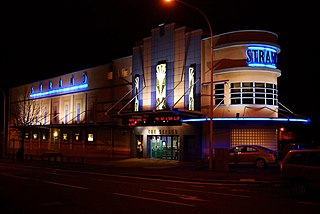
The Strand Arts Centre, also known as Strand Cinema is an independent four-screen cinema on Holywood Road in Belfast, Northern Ireland. It is one of the two remaining independent cinemas in Belfast, alongside the Queen's Film Theatre. It is the only operational picture house in Northern Ireland down from a total of 40 during the genre's peak popularity.

The Glasgow Film Theatre (GFT) is an independent cinema in the city centre of Glasgow. GFT is a registered charity. It occupies a purpose-built cinema building, first opened in 1939, and now protected as a category B listed building.
Kingsland Secondary School was a school located on Shacklewell Lane in the London Borough of Hackney, England. It closed in August 2003.

The State Theatre is a heritage-listed theatre, located at 47-51 Market Street, in the Sydney central business district in the City of Sydney local government area of New South Wales, Australia. The theatre was designed by Henry Eli White with assistance from John Eberson and built between 1926 and 1929. It hosts film screenings, live theatre and musical performances, and since 1974 it has been the home of the annual Sydney Film Festival. It is also known as State Building and Wurlitzer Organ. The property is privately owned. It was added to the New South Wales State Heritage Register on 2 April 1999.
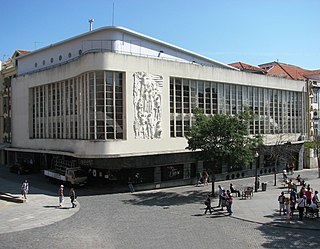
The Cinema Batalha is a Portuguese cinema and concert venue in civil parish of Cedofeita, Santo Ildefonso, Sé, Miragaia, São Nicolau e Vitória, municipality of Porto. Originally known as the Salão High-Life, it was moved from Boavista by its owners to its current location, and rebuilt by architect Artur Andrade in the Art-Deco style, re-inaugurated on 3 June 1947. After many years of success, the building and the cinema began losing customers, and was closed in 2003.

George Coles (1884–1963) was an English architect, known mostly as a designer of Art Deco cinema theatres in the 1920s and 1930s.

Troxy is a Grade II-listed Art Deco music venue on Commercial Road in Stepney, London. Built as a cinema in 1933, it closed in 1960 and became a training school for the London Opera Centre. In the 1980s the building was used as a bingo hall, and the Troxy was converted to a live events space in 2006. The building is considered a vital part of East London's history and was Grade II listed in 1990. It has a capacity of 3,100.

The Four Aces Club was a pioneering music and recreational space on Dalston Lane in Dalston, London. Based in a building that had formerly been the North London Colosseum and Amphitheatre and then a cinema, in the 1960s and 1970s the club became one of the first venues to play black music in the United Kingdom. It was credited with playing a significant "role in the evolution of reggae into dance music, from ska, to rocksteady, to dub, to lovers, to dancehall and the evolution of jungle." Many notable Afro-Caribbean musicians appeared at the Four Aces, which was often referred to as "the jewel in Dalston's crown". As well as reggae and dub artists, its clientele over the years including stars such as Bob Marley, Stevie Wonder and Jimmy Cliff.

Dalston Square is a largely residential complex located just off Kingsland Road near Dalston Junction station in Dalston, part of the London Borough of Hackney. It includes approximately 500 homes, a library, public space, shops and restaurants.

Power Lunches Arts Café was a music venue, rehearsal space, and creative hub located on Kingsland Road in Dalston, a district of the London Borough of Hackney. It opened in 2011 and closed in 2015. It started out with gigs planned to be only at weekends, but later became a prominent feature of Hackney’s DIY music scene with gigs most nights every week. Though originally genuinely also a café, it eventually stopped serving food.

Passing Clouds was a community run music venue near Kingsland Road, Dalston in East London. Founded in 2006, the venue was used for a range of activities. It was closed down in 2016, squatted and then finally evicted. After a period of dereliction it was announced in 2019 that it would re-open as a different venue.
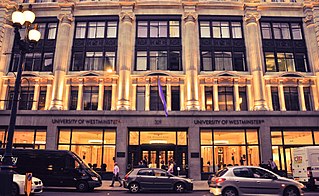
The Regent Street Cinema is an independent British cinema located on Regent Street, London.
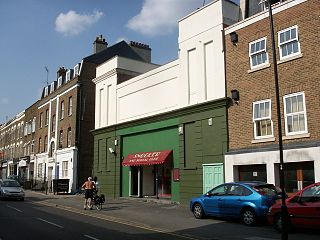
The Castle Cinema is an independent cinema based in the Homerton area of Hackney, London. The venue consists of an 82-seat main screen, a 27-seat secondary screen, as well as an Art Deco bar and restaurant that can accommodate up to 120 people.
Frank Ernest Bromige, commonly known as F.E. Bromige was a British architect of the Modernist and Art Deco styles. He is principally known for designing leisure buildings, especially cinemas, working mainly in Greater London and surrounding areas.



















